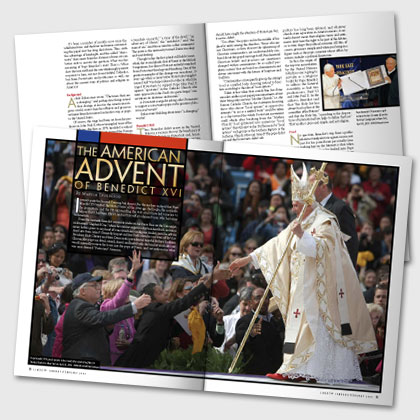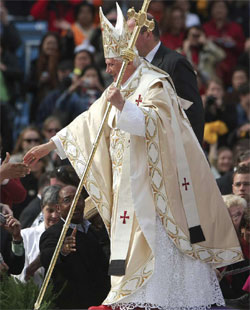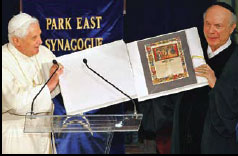The American Advent of Benedict XVI
Martin Trueblood January/February 2009
It wasn’t quite the Second Coming, but almost. For the six days in April that Pope Benedict XVI visited the United States, all the coverage, the hoopla, the accolades, the promotion, and the PR surrounding the visit could have led someone to believe that it had been Christ, and not His self-proclaimed vicar, who had come to America.
From the moment Benedict arrived at Andrews Air Force Base on the Vatican jet, nicknamed “Shepherd One,” where he was met in person by President Bush, an honor never before given to any head of state (much less a religious leader), until he left six days later from John F. Kennedy Airport in New York, when he was seen off by Vice President Dick Cheney and then Democratic presidential hopeful Hillary Rodham Clinton, the pope was feted, wined, dined, and hailed with the kind of accolades one would normally reserve for Jesus, not the pope of Rome, and certainly not in what was once deemed “Protestant” America.
It’s been a number of months now since the whirlwind tour, and the fever and mania surrounding the papal visit has long died down. Thus, with the advantage of hindsight, and the added “objectivity” that comes from the distance of time, we can better seek to answer the question What was the meaning of Pope Benedict’s visit? That is, What does the visit itself and the overwhelmingly positive response to him, not just from faithful Catholics, but from Protestants and politicians as well, say about the current state of politics and religion in America?

Pope Benedict XVI greets people in the crowd after celebrating Mass at Yankee Stadium in New York on April 20, 2008. CHANG W. LEE/AFP/Getty Images
Background
As Bob Dylan once wrote, “The times, they are a-changing,” and perhaps few things reveal that change, at least in the American religious world, more than the effusive and gracious welcome Benedict received on his first trip, as pope, to the United States.
Of course, the stage had been set from his predecessor, John Paul II, whose triumphal tours of the United States, the first in 1979, heralded a radical shift in the American attitude toward the Roman Catholic Church. It wasn’t so much that John Paul’s charm and charisma changed American attitudes toward Rome (though no doubt to some degree it did); rather, the force of his charm and personality simply brought out what has been brewing for years now, which was that the fervent nativism and anti- Catholicism that had so long been a powerful subtext in American society was all but dead.
Social scientists can debate the reasons for the change because, like all social issues, it’s no doubt fairly complicated. But one reason is that the strong Protestant hold on American culture and thought has for many decades simply been dying away. And, because Protestantism itself—originally founded on a revolt, a bitter one at that, against Roman Catholicism—was the main carrier of anti- Roman sentiment, it is only natural that as the influence of Protestant thinking has waned, so has anti-Catholic sentiment waned.
Even more consequentially, there has been a slow but steady change within Protestantism itself regarding Rome. From the time of Martin Luther, pretty much into the early decades of the twentieth century, many Protestants—particularly fundamentalists and to a degree evangelicals—railed against Rome as the antichrist, as one of the beast powers in the book of Revelation (beasts in Bible prophecy are usually understood as religious and/ or political powers), as the “great whore of Babylon,” and the like. The Reformation itself was grounded on two crucial planks: salvation by faith alone, and Rome as the antichrist. Martin Luther (in his own inimitable style) had called the pope “the head of the accursed church of all the worst scoundrels on earth,” “a vicar of the devil,” “an adversary of Christ,” the “antichrist,” and “the man of sin.” And those were his softer comments! The point is, the animosity toward Rome was deep and unrelenting.
Though today, the first plank still holds (somewhat), the second plank, that of Rome as the biblical boogeyman, has almost (but not entirely) vanished from Protestant theology and thinking. One of the greatest examples of this change was seen about 10 years ago when a conservative Protestant evangelist named Jack Van Impe released a video in which he urged Protestants to support Pope John Paul II against “apostates” in the Catholic Church who were opposed to John Paul’s (to quote Impe) “conservatism on doctrines and morals.”
A Protestant evangelist asking other Protestants to support a conservative pope on the question of doctrine and morals?
Dylan wasn’t kidding about times “a-changing,” was he?
Benedict’s Visit
Thus, Benedict didn’t arrive in the United States in a vacuum. He was the beneficiary of a radical change in Protestant and, hence, American thought and attitudes. To a certain degree, the stage had already been set. He just needed to play the role expected of him, and that he did masterly. He’s no John Paul II; then again, he didn’t need to be. Benedict XVI did just fine.
Though very conservative on doctrinal matters (before becoming the 265th Roman pontiff, Cardinal Joseph Ratzinger was the prefect of the Congregation for the Doctrine of the Faith—the top theological post at the Holy See, the body that had carried out the Inquisition), he was able to strike a conciliatory-enough tone regarding the relationship between Rome and other Protestant churches, and with the Jews as well.
In one of many “historic firsts,” Benedict visited a synagogue in the United States, where—standing before a model of the ark of the covenant at an Upper East Side synagogue—the pope, once nicknamed “God’s Rottweiler,” extended his whiterobed arms and uttered to a group of about 100 prominent Jewish New Yorkers: “Dear friends, Shalom.” This is a long way from Pius XII, often dubbed “Hitler’s Pope.”
Meanwhile, Benedict’s speech at St. Joseph’s Church in Yorkville, New York, at a prayer service with about 250 Protestant leaders, showed that “God’s Rottweiler” knew all the right buttons to push, all the right phrases to say, without having to compromise anything that he, as a Roman Catholic, deems sacred. In fact, though most folks were caught up in the moment, they might have missed some of the nuances of his speech. One in particular should have caught the attention of Protestants but, it seems, didn’t.
“Too often,” the pope said in the middle of his plea for unity among the churches, “those who are not Christians, as they observe the splintering of Christian communities, are understandably confused about the gospel message itself. Fundamental Christian beliefs and practices are sometimes changed within communities by so-called ‘prophetic actions’ that are based on a hermeneutic not always consonant with the datum of Scripture and tradition.
“Communities consequently give up the attempt to act as a unified body, choosing instead to function according to the idea of ‘local options.’”
Taken at face value, that sounds fine, but if one considers endless past papal pronouncements about there being only one true “Mother Church,” i.e., the Roman Catholic Church, the statement decrying those who choose “local options” as opposed to attempts “to act as a unified body” could be taken as a slap toward the whole Protestant movement itself, which after breaking from the “Mother Church” had splintered into numerous “local options” that still exist today. Did he mean by “local options” such groups as the Southern Baptists or the Lutheran Church-Missouri Synod? The pope didn’t say and the Protestants didn’t ask.
Politics or Religion?
From the start, questions were raised about the nature of Benedict’s visit. Was it religious or
Pope Benedict XVI presents a gift to Rabbi Arthur Schneier (R) at the Park East Synagogue in New York, April 18, 2008. REUTERS/Gary Hershorn political, a topic made even more sensitive because he came amid a heated political season. Plus, the pope is not just the spiritual head of the Roman Catholic faith; he’s also the political ruler of Vatican City. And though President Bush insisted that the visit was not political, the White House had received the pontiff with the pomp and circumstance given to a head of state, and not to a “preacher” (could one imagine Bush, or any president, going to the airport to meet Billy Graham?).
The topics discussed in the private meeting between the president and the pope included the war in Iraq, the Israeli-Palestinian conflict, recent developments in Lebanon, and, according to a statement released by the Vatican, they discussed “current moral and religious questions, including those related to human rights and religious freedom, the defense and promotion of life, marriage and the family, education of new generations and sustainable development.”

Pope Benedict XVI presents a gift to Rabbi Arthur Schneier (R) at the Park East Synagogue in New York, April 18, 2008. REUTERS/Gary Hershorn
Though some topics are more directly political than others, as often is the case most moral and/or spiritual issues inevitably have a political dimension, since they are often impacted by law and public policy. Where exactly the line should be drawn between what’s simply morality and what’s simply politics has long been debated, and whatever church-state separation in America means, it certainly doesn’t mean that religious views and sentiments don’t have the right to be part of the debate, or to even shape the political outcome. All this, of course, gets more complicated when you bring in a figure such as the pope, someone whose office, by nature, includes a political dimension.
In fact, the origin of the trip was an invitation by the United Nations (which no one is going to mistake as a religious body) for Pope Benedict to address the General Assembly, as had two predecessors, Paul VI and John Paul II. In the address, Benedict said that “the Holy See has always had a place at the assemblies of the Nations” and that the Holy See, “according to the dispositions of international law, helps to define that law.” That’s politics, pure and simple, and not religion.
Proof
No question, Benedict’s trip from a public relations standpoint was a great success, not just for his pontificate personally (one rumor making hay on the Internet is that when asked what he saw when he looked into Pope Benedict’s eyes, President Bush is said to have responded, “God.”), but for the Roman Catholic Church in America as a whole, which still has been reeling from the clergy abuse scandal.
His trip is proof, too, that not only has there been a massive healing in the great Protestant- Catholic divide, but that many Protestants see the Papacy no longer as an enemy but, in many cases, as an ally in the numerous political/moral issues that mean a lot to them. This is a radical change, one that could have profound implications for the political future of this country.
In short, Pope Benedict XVI’s visit is another symbol of an amazing historical shift in American and Protestant attitudes toward a political-religious institution that for many years had been viewed as antithetical to all that Americanism and Protestantism stood for. Even more amazing is how Protestants themselves have been the most eager ones to reach across that gulf and embrace Rome. What that change means for American politics can be monumental in scope. History is being made; it’s just hard to see it as such when you are right there as it is taking place.